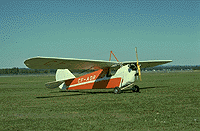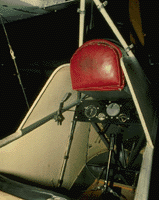|

Aeronca
C-2 / C-3


-
Designed By:
Aeronautical Corporation of America, United
States
-
Period:
Interwar (1919-1938)
-
Uses: General
Aviation
-
First Flight:
October 20, 1929
The C-2 was designed to be a cheap and simple
flying machine for the amateur pilot. Built at the
beginning of the Great Depression, it appealed to
those who could not afford larger more expensive
airplanes because of its relatively low price.
After the C-2 appeared at a Montreal air meet in
1930, the Aeronautical Corporation of Canada was
formed in Toronto. This company imported and sold
17 C-2s and C-3s during the 1930s. Approximately
515 C-2s and C-3s had been made when production
stopped in 1937.

A
C-2 was flown higher than 6 000 m (20 000 ft), and
one fitted with special fuel tanks remained aloft
for 26 hours. The C-2 was dubbed the "flying
bathtub" due to its unusual fuselage contour.

The
C-2-N (above) is a development of the C-2 using
the 36 hp E-113A engine replacing the original 30
hp E-107A. Four C-2-Ns were built and NC13089 is
one of two remaining.
NC13089
set the following records:
-
Irene
I. Crum - International Altitude Record
19,425.814 ft.
-
Howard
C. Mayes Jr. - Altitude Record for Junior pilots
19,997 ft.
-
Benjamin King - 500 km speed record for
single-seat light seaplanes 70.499 mph.
-
Benjamin King - Airline distance record for
single-seat light seaplanes 230.314 mi.
Benjamin King - International Altitude Record,
single-seat light seaplanes 15,081.976 ft.
Benjamin King - 100 km speed record, single-seat
light seaplanes 80.931 mph.
Benjamin King - Airline distance record, light
seaplanes 221.20 mi.
The
engine is an early model E-113 and only has a
single magneto ignition system. Later, Aeronca
E-113 engines all featured dual magnetos as
required by the new safety standards of 1938. It
consumes about 3 gallons of gas per hour at
cruising speed (85% power). The fuselage has
welded steel tubing covered by fabric and the
wings are fabric-covered spruce.
Specifications (C2)
- Wing Span:
11 m (36 ft)
Length: 6.0 m (20 ft)
Height: 2.3 m (7 ft 6
in)
Weight, Empty:
184 kg (406 lb)
Weight, Gross:
317 kg (700 lb)
Cruising Speed: 105 km/h (65
mph)
:
Max Speed:
129 km/h (80
mph)
Rate of Climb:
137 m/min (450
ft)
Service
Ceiling: 5,030 m (16,500
ft)
Range: 322 km (200 mi)
Power Plant:
one Aeronca
E-113, 36 hp, horizontally opposed engine

C3
The more powerful Aeronca C-3
was introduced in 1931, featuring room for a
passenger seated next to the pilot. Powered by a
new 36-horsepower (27-kilowatt) Aeronca E-113
engine, the seating configuration made flight
training much easier and many Aeronca owners often
took to the skies with only five hours of
instruction—largely because of the C-3's
predictable flying characteristics. Both the C-2
and C-3 are often described as “powered gliders”
because of their gliding ability and gentle
landing speeds—it was almost impossible to make a
hard landing with an Aeronca because the pilot
could easily see his wheels approach the runway.
The C-3's distinctive razorback
design was drastically altered in 1935 with the
appearance of the “roundback” C-3 Master.
Retaining the tubular fuselage frame construction,
the C-3 Master featured a smaller vertical
stabilizer and rudder with a “filled out” fuselage
shape that created the new “roundback” appearance
and improved the airflow over the tail. With an
enclosed cabin (brakes and wing light still cost
extra), the 1935 C-3 Master was priced at only
$1,890—just a few hundred dollars more than the
primitive C-2 of 1929. The low price generated
significant sales; 128 C-3 Masters were built in
1935 alone and the 500th Aeronca aircraft also
rolled off the assembly line that same year.
A version of the C-3 with
fabric-covered ailerons (instead of metal),
designated the Aeronca 100, was built in England
under license by Light Aircraft Ltd. (operating as
Aeronautical Corporation of Great Britain Ltd.)
but the expected sales never materialized—only 24
Aeronca 100s were manufactured before production
was halted.
Production of the C-3 was
halted in 1937 when the aircraft no longer met new
U.S. government standards for airworthiness. Many
of the C-3's peculiarities—external wire braces,
extensive fabric construction, single-ignition
engine, and lack of an airspeed indicator—were no
longer permitted. Fortunately for the legion of
Aeronca owners, a “grandfather” clause in the
federal regulations allowed their airplanes to
continue flying, although they could no longer be
manufactured.
 |
